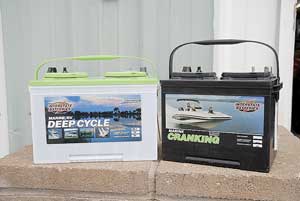
These guides love hard baits for catching quantity and quality of speckled trout and redfish this time of year.
Marine batteries come in three types, and they are not interchangeable. Each is designed to do a particular job, and while some can be used in cross-over applications, doing so can result in a reduction of battery performance and life.
Cranking batteries
Cranking batteries are designed to start marine engines. Batteries produce power as acid transfers from their electrolyte to their plates. A cranking battery needs to produce a lot of power in a short period of time to start an engine. Cranking batteries are built with a relatively large number of thin plates because the most efficient way to accomplish this is to present as much plate surface area as possible to the electrolyte.
Once the engine starts, its charging system immediately replenishes the power used during cranking, and carries any electrical loads from accessories and the engine systems. The battery loafs along until the next engine start.
The amount of battery power required to start an engine is listed in its owner’s manual stated as marine cranking amps (MCA), cranking amps (CA) or cold cranking amps (CCA).
Automotive and some marine batteries carry only a CCA rating. It tells you how many amps a new battery at 0 degrees can deliver for 30 seconds while maintaining at least 7.2 volts.
MCA and CA ratings are derived from the same test but done with the new battery at 32 degrees. The most important thing here is to compare apples to apples — you can compare MCA and CA ratings on different batteries directly, but a CCA rating comes from a different test and can only be compared to another battery’s CCA number.
Deep-cycle batteries
Deep-cycle batteries are designed to produce fewer amps over a longer period of time before being recharged. The Reserve Capacity (RC) rating on their labels tells you the number of minutes that a new, fully-charged battery can power a 25-amp load at an ambient temperature of 80 degrees without falling below 10.5 volts.
The amp-hour (AH) rating is another popular measurement for battery capacity. It tells you how many amps a battery at 80 degrees can deliver per hour for 20 hours without falling below 10.5 volts.
For example, a 100AH battery can deliver 5 amps for 20 hours. Using the 20-hour rate as a standard is important because the faster you pull amps from a battery, the fewer total amps you get before it is discharged. The 100AH battery that can deliver 5 amps for 20 hours may only deliver 20 amps for a bit over 4 hours.
Dual-purpose batteries
Deep-cycle batteries with an MCA rating appropriate for your engine can be used for engine cranking, but the opposite is not true. The thin plates found in cranking batteries die quickly when used for deep cycling.
Dual purpose batteries are built with plates heavy enough to withstand moderate deep cycling and have enough plate area to handle engine cranking. They are great for boats that have room for only one battery to cranking the engine and run an electric trolling motor. These batteries are a compromise: They don’t start engines as well as a cranking battery, and they can’t handle as much deep cycling as a deep cycle battery.
Personally, I’d rather use the biggest deep cycle model that I could squeeze into a boat’s single battery size and weight limits.
The bottom line
Using a purpose-built battery for each of your boating needs gives you the best performance and longest service for your money.


